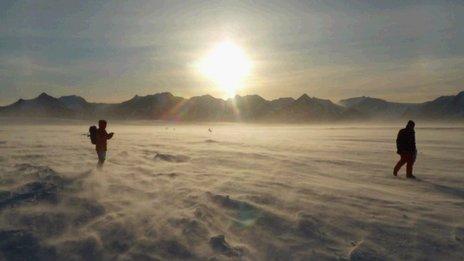Lake Ellsworth drilling: First images emerge
- Published
- comments

New pictures from Antarctica capture the moment that a search for life under the ice-sheet finally got under way.
The project to investigate Lake Ellsworth involves using a hot-water drill, aiming for waters isolated for up to half a million years.
The first stage of the operation was to fire up the boiler that is being used to melt vast quantities of snow.
According to project manager Chris Hill, "this was not as straightforward as we would have liked".

"The main burner unit blew a circuit board, the boiler kept over‐pressurising when it fired and we then found that it was not burning as cleanly as we had been expecting."
Eventually the problems were fixed and the team went on to melt 180,000 litres of snow, which produced 60,000 litres of water.
Once the right amount of water had been produced, it was then passed through a series of four filters and an ultra-violet light chamber to ensure complete sterility.
Writing on the EllsworthLIVE blog, external, Chris Hill said: "We are now committed, having gone past the point of no return.
"If anything stops working now, water could freeze in the pipes and the whole programme could come to a halt. So please keep us in your thoughts as we work round the clock for the next seven to 10 days."
The next task is to melt a cavity 300m under the ice to act as a water storage system so that the pressure in the bore-hole can be equalised.

Lake Ellsworth is not only below sea level but is also under extreme pressure from the ice-sheet so the challenge is to ensure that when the lake is reached, there is no sudden surge of lake water to the surface.
The water in the cavity will help balance the pressure and allow the team to ensure that melt-water from the drilling does not enter the lake and vice versa.
The drilling phase of the operation is planned to last five days. Once complete, the bore-hole is predicted to remain open for no more than 24 hours - a narrow window for the sampling devices to be deployed.
The first samples of water are scheduled to reach the surface early next week and should answer a fundamental question: can any form of life survive in the extreme conditions of pitch darkness and immense pressure?
Cameraman Pete Bucktrout of the British Antarctic Survey is on location to record the operation.
- Published10 December 2012
- Published12 December 2012
- Published10 August 2012
